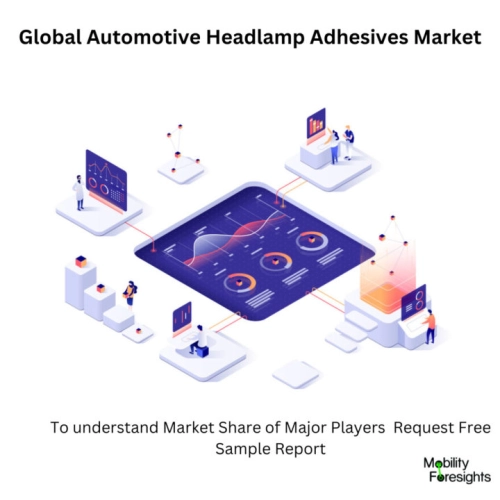
- Get in Touch with Us

Last Updated: Apr 25, 2025 | Study Period: 2023-2030
INTRODUCTION
Adhesives are used in the assembly of headlights to join the lens to the housing, replace a sealant, and protect the sophisticated technology from water.
PUR hot melts with a black color offer protection from intense sunlight. Nowadays, polycarbonate is used to make the majority of headlight lenses.
Polycarbonate is a polymer that is thermoplastic. This indicates that it is highly resistant to heat and can withstand the lighting material's high temperatures.
Polycarbonate also has a transparency that is similar to that of glass, is very rigid, and can withstand both impacts and breaks at the same time.
The material made of plastic can be easily molded into intricate shapes, which is a significant advantage over glass. Additionally, polycarbonate is 250 times stronger than standard glass, weighs half as much, and offers advantages in both aesthetics and functionality.
The flexible and waterproof silicone adhesive known as Permatex is ideal for resealing headlights. Convertible top adhesives must also meet stringent requirements. The adhesive must be extremely resistant to hydrolysis and remain flexible even under intense sunlight and high temperatures. The high-performance PUR adhesives for convertible tops are also available in black for a superior appearance and UV resistance.
GLOBAL AUTOMOTIVE HEADLAMP ADHESIVES MARKET SIZE AND FORECAST

The Global automotive headlamp adhesives market accounted for $XX Billion in 2022 and is anticipated to reach $XX Billion by 2030, registering a CAGR of XX% from 2023 to 2030.
NEW PRODUCT LAUNCH
Dymax has been providing tier one automotive headlamp manufacturers with adhesives and sealants for more than 40 years. The company was a pioneer in the development of UV light-curable adhesives for head lamp assembly. Manufacturers of vehicle lighting can significantly cut production costs thanks to new adhesive technology application opportunities.
For headlamp assembly, solvent-free adhesives cure instantly and offer in-line cure for immediate quality control inspection. They form strong structural bonds to glass, metal, plastic, and substrates that are difficult to bond to despite their resistance to harsh environments and high temperatures. For brighter headlamps, high-strength gap filling enables smaller bond areas and larger reflective surfaces.
Dymax adhesives are excellent for sealing LED light assemblies, bonding lenses to reflector housings, and sealing vent holes. For optimal performance and cost savings, successful light-curing processing necessitates that the curing equipment be matched to the resin.
Dymax specializes in developing the most effective light-curing processes for specific applications and produces curing systems and light-curable materials.
COMPANY PROFILE
THIS REPORT WILL ANSWER FOLLOWING QUESTIONS
| Sl no | Topic |
| 1 | Market Segmentation |
| 2 | Scope of the report |
| 3 | Abbreviations |
| 4 | Research Methodology |
| 5 | Executive Summary |
| 6 | Introduction |
| 7 | Insights from Industry stakeholders |
| 8 | Cost breakdown of Product by sub-components and average profit margin |
| 9 | Disruptive innovation in the Industry |
| 10 | Technology trends in the Industry |
| 11 | Consumer trends in the industry |
| 12 | Recent Production Milestones |
| 13 | Component Manufacturing in US, EU and China |
| 14 | COVID-19 impact on overall market |
| 15 | COVID-19 impact on Production of components |
| 16 | COVID-19 impact on Point of sale |
| 17 | Market Segmentation, Dynamics and Forecast by Geography, 2023-2030 |
| 18 | Market Segmentation, Dynamics and Forecast by Product Type, 2023-2030 |
| 19 | Market Segmentation, Dynamics and Forecast by Application, 2023-2030 |
| 20 | Market Segmentation, Dynamics and Forecast by End use, 2023-2030 |
| 21 | Product installation rate by OEM, 2023 |
| 22 | Incline/Decline in Average B-2-B selling price in past 5 years |
| 23 | Competition from substitute products |
| 24 | Gross margin and average profitability of suppliers |
| 25 | New product development in past 12 months |
| 26 | M&A in past 12 months |
| 27 | Growth strategy of leading players |
| 28 | Market share of vendors, 2023 |
| 29 | Company Profiles |
| 30 | Unmet needs and opportunity for new suppliers |
| 31 | Conclusion |
| 32 | Appendix |